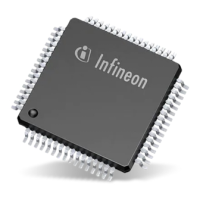Introduction to Digital Power Conversion
XMC4000/1000 Family
Converter Topologies
Application Guide 21 V1.0, 2015-01
3.4 Phase-Shift Full-Bridge (PSFB)
The PSFB is a Phase-Shift-Full-Bridge DC/DC converter. Power is transferred in a Phase-Shift (PS)
via a Full-Bridge (FB), a transformer, a rectifier and filter. The PSFB is an isolating converter.
Figure 9 PSFB Principle
PSFB power conversion stages
Stage one
− Split the DC rail input voltage (V
IN
) into two Phase-Shifted pulse streams (Ph
A
, Ph
B
) according
to the Full-Bridge control signals.
Stage two
− A transformer, which is fed onto its primary coil (n
p
) with the phase difference voltage (Ph
A
,
Ph
B
). This difference voltage will be transformed with a ratio (n
s
:
n
p
) to two secondary coils (n
s
,
n
s
).
Stage three
− A “step-down” converter configuration with two diodes (D
A
, D
B
) that rectify and interleave the
positive levels of the two secondary voltages respectively into a PWM pulse stream. These
PWM pulses have a duty cycle that corresponds to the phase shift |Ph
A
o
–
Ph
B
o
|, and will be
filtered via the inductor (L) into the output capacitor (C), and result as an output voltage (V
OUT
).
− The PSFB total voltage conversion ratio (V
OUT
/ V
IN
) is proportional to the transformer winding-
ratio (n
s
:
n
p
) times the phase-shift |Ph
A
o
–
Ph
B
o
|:
V
OUT
/ V
IN
= (n
s
:
n
p
) * |Ph
A
o
–
Ph
B
o
| / 180
o

